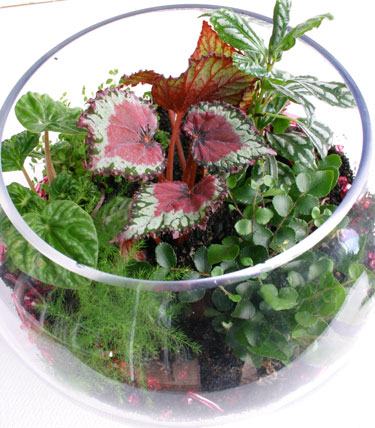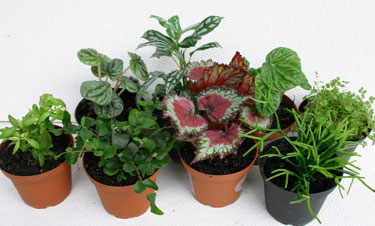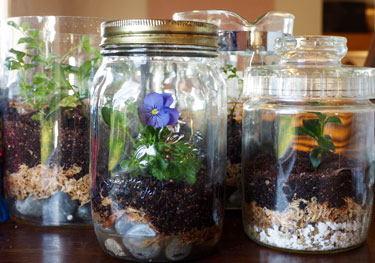Kids Go Gardening - terrariums
It's a small world
When the days are shorter there’s less time to play outdoors winter is a good time to bring a bit of nature indoors! Grow your own houseplants or take it a step further and create a magical terrarium!
A terrarium is glass container with plants growing in it. You can find one in a garden centre, or look around home or in a second hand shop for something to up-cycle into your terrarium. It might be an old glass vase, a fish bowl, a coffee plunger, or even a cut down large plastic bottle.
With plants growing in it, the terrarium becomes a mini climate of its own. The leaves release water vapour (gas), which turns back into liquid on the glass and trickles back down onto the soil, just like rain! If the terrarium has a lid, it can go weeks without watering.
Ferns and tropical plants are great for terrariums because they love humidity - damp misty air around their leaves. Look for tiny houseplants in the garden centre. You might also find tiny plants growing in the garden or check if your indoor plants have little side shoots or baby plants growing on them.
Some terrariums have just one plant. In a large container you can make a fairy forest, Jurassic jungle and a tropical rainforest.
How to plant a terrarium
You will need:
- A glass container
- Some small pebbles
- Spaghnum moss (or a piece of fabric)
- Potting mix
- Small plants
- Start with a layer of pebbles, at least 3cm deep (deeper for a larger container for drainage.
- Add a thin bed of damp sphagnum moss or open weave fabric over the pebbles. This stops the potting mix falling down into the pebbles, while letting the water drain through.
- Use a spoon to carefully add some fresh potting mix, deep enough for your plant roots. Ideally the container should be no more than half full at this stage.
- Try out your plant (or plants) position until you are happy with your arrangement. Take the plant out of its pot, make a hole and carefully plant it. A spoon, small tongs or chopsticks may be helpful. Leave some space for plants to grow and spread.
- Get creative! You might decorate your mini world with colourful beads, toy animals or little pieces of wood.
Terrarium care
- Keep your terrarium where it gets plenty of light but not direct sun. Sun shining through the glass will burn the plants.
- Make sure your plants are not diseased. Disease can spread quickly in a terrarium. Pick off any leaves that look sick.
- Water very carefully, using a mist spray bottle or small watering can. Not too much! If there’s condensation on the glass, don’t water.
- Feed about once a month with liquid houseplant food (1/4 strength).
- If the terrarium gets crowded you may need to prune off some leaves or take out a whole plant. Quickly remove any plant that looks sick or dies.
Did you know?
- Evapotranspiration happens when a plant releases water onto the outside of its leaves, the liquid water turns into a gas (water vapour) which is released into the air. It’s just like sweating for plants and it cools them down.
- The New Zealand native hen and chicken fern or ‘pikopiko’ grows babies at the ends of it’s fronds. You can cut these tiny ferns off and plant them in good clean seed raising mix (Yates Black Magic Seed is ideal). A new baby houseplant in an instant!
Good terrarium plants
Ferns
Peperomia
Pilea
Black mondo grass
Polka dot plant
Baby’s tears
African violet
Spider plant

7-Jun-2018

Indoor terrarium

Suitable small plants for a terrarium

A variety of terrarium jars

